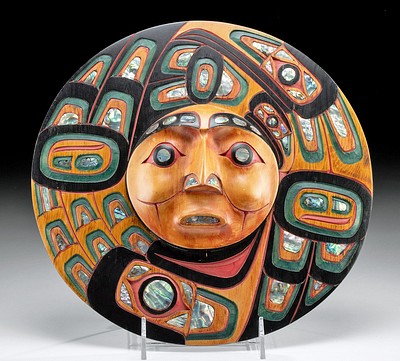Exhibited Egyptian Faience Taweret Amulet
Lot 24
About Seller
Artemis Fine Arts
686 S Taylor Ave, Ste 106
Louisville, CO 80027
United States
Selling antiquities, ancient and ethnographic art online since 1993, Artemis Gallery specializes in Classical Antiquities (Egyptian, Greek, Roman, Near Eastern), Asian, Pre-Columbian, African / Tribal / Oceanographic art. Our extensive inventory includes pottery, stone, metal, wood, glass and textil...Read more
Estimate:
$1,500 - $2,000
Absentee vs Live bid
Two ways to bid:
- Leave a max absentee bid and the platform will bid on your behalf up to your maximum bid during the live auction.
- Bid live during the auction and your bids will be submitted real-time to the auctioneer.
Bid Increments
| Price | Bid Increment |
|---|---|
| $0 | $25 |
| $300 | $50 |
| $1,000 | $100 |
| $2,000 | $250 |
| $5,000 | $500 |
| $10,000 | $1,000 |
| $20,000 | $2,500 |
| $50,000 | $5,000 |
| $100,000 | $10,000 |
| $200,000 | $20,000 |
About Auction
By Artemis Fine Arts
Dec 7, 2023
Set Reminder
2023-12-07 10:00:00
2023-12-07 10:00:00
America/New_York
Bidsquare
Bidsquare : Fine Antiquities, Ancient & Pre-Columbian Art
https://www.bidsquare.com/auctions/artemis-gallery/fine-antiquities-ancient-pre-columbian-art-14361
Classical antiquities, ancient, and ethnographic art from cultures encompassing the globe. Egyptian, Greek, Roman, Etruscan, Near Eastern, Asian, Pre-Columbian, Native American, African / Tribal, Oceanic, Spanish Colonial, Fine / Visual Arts, so much more! Artemis Fine Arts info@artemisfinearts.com
Classical antiquities, ancient, and ethnographic art from cultures encompassing the globe. Egyptian, Greek, Roman, Etruscan, Near Eastern, Asian, Pre-Columbian, Native American, African / Tribal, Oceanic, Spanish Colonial, Fine / Visual Arts, so much more! Artemis Fine Arts info@artemisfinearts.com
- Lot Description
Ancient Egypt, Late Dynastic Period, 26th to 31st Dynasty, ca. 664 to 332 BCE. A stunningly detailed, mold-formed faience figure of Tawaret (also Taweret, Tauret, Apet, Opet), the goddess of child birthing and suckling as well as a protector of women, children, and the weak. Tawaret's composite form is defined with the feet of a lioness, the spine and tail of a crocodile, the breasts and bulging belly of a pregnant woman, and the head of a hippopotamus. Standing in a striding pose atop an integral plinth, Tawaret presents with her left foot forward, both arms placed defensively against her womb, and shoulders back in a relaxed manner. Her veristic visage bears petite, almond-shaped eyes above puffy cheeks, a bi-lobed snout with bared teeth and protruding tongue, and perky ears framed with the striated lappets of her incised tripartite wig. An integral suspension loop along the dorsal spine indicates this figure was at one time worn as a pendant either by a living individual or perhaps a mummified woman who died in childbirth. Size: 0.62" L x 0.45" W x 1.65" H (1.6 cm x 1.1 cm x 4.2 cm)
According to scholar Paul Hamlyn, "[Tawaret] was especially worshipped in Thebes where, under the New Kingdom, she enjoyed great popularity among people of the middle class, who often gave her name to their children and decorated their houses with her images. As well as her role of protectress Taueret sometimes fulfilled that of an avenging deity: then she would appear as a goddess with the body of a hippopotamus but the head of a lioness who brandished a dagger in a menacing manner." (Paul Hamlyn Limited. "Egyptian Mythology." Tudor Publishing Company, New York, 1965, p. 110)
ex-Emil Brugsch Collection, curator of the Bulaq Museum, Cairo, Egypt; Exhibited at the Drexel Museum, Philadelphia, 1895 to 1914; with the Drexel Institute Collection, Minneapolis Museum of Art, 1915 to 1958, ref. no. 16.68; at the Los Angeles County Museum of Art (LACMA) from 1986 to 1991; and in the University of Arizona Museum of Art, October 1993 to December 1993.
Cf. The Metropolitan Museum of Art, accession number 04.2.365
Provenance: Collection of Dr. W. Benson Harer, Los Angeles, California, USA; ex-L. Blumka collection, acquired in 1958; ex-Emil Brugsch Collection, curator of the Bulaq Museum, Cairo, Egypt; Exhibited at the Drexel Museum, Philadelphia, 1895 to 1914; with the Drexel Institute Collection, Minneapolis Institute of Art, 1915 to 1958, ref. no. 16.68; at the Los Angeles County Museum of Art (LACMA) from 1986 to 1991; and in the University of Arizona Museum of Art, October 1993 to December 1993
All items legal to buy/sell under U.S. Statute covering cultural patrimony Code 2600, CHAPTER 14, and are guaranteed to be as described or your money back.
A Certificate of Authenticity will accompany all winning bids.
We ship worldwide and handle all shipping in-house for your convenience.
#182345Minor pitting and abrasions, with light fading to glaze in a few areas, otherwise intact and excellent. Great preservation to finer details and overall form.Condition
- Shipping Info
-
All shipping is handled in-house for your convenience. Your invoice from Artemis Gallery will include shipping calculation instructions. If in doubt, please inquire BEFORE bidding for estimated shipping costs for individual items.
-
- Buyer's Premium



 EUR
EUR CAD
CAD AUD
AUD GBP
GBP MXN
MXN HKD
HKD CNY
CNY MYR
MYR SEK
SEK SGD
SGD CHF
CHF THB
THB














